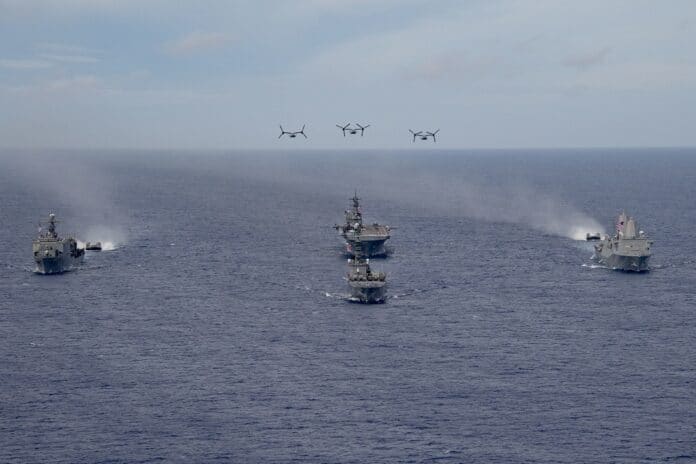
The U.S. Navy’s forward-deployed ships of Amphibious Squadron (PHIBRON) 11 conducted bilateral amphibious operations with the Japan Maritime Self Defense Force (JMSDF) tank landing ship JS Shimokita (LST 4002) in the Philippine Sea, June 12-13.
USS America (LHA 6), USS New Orleans (LPD 18) and USS Germantown (LSD 42) comprise the Navy’s only forward-deployed amphibious ready group (ARG), which operates with allies and partners throughout the Indo-Pacific.
“The value gained by our interoperations with the JMSDF cannot be overstated. As we continue to improve our interoperability we demonstrate dynamic capabilities responsive to any crises,” said Capt. Greg Baker, PHIBRON 11 commodore. “Honing and refining our fundamental skills together makes us a more flexible, formidable team when called upon to support one another in crisis.”
America, lead ship of the ARG, conducted cross-deck aircraft operations with Shimokita, June 12, followed by coordinated divisional tactics, or DIVTACs, June 13.
“What a great opportunity this was to operate with our most trusted partner in this region yet again,” said Capt. Ken Ward, America’s commanding officer. “As always, the precision and professionalism of Shimokita’s captain and crew ensured a safe and rewarding exchange of aircraft and ARG landing craft, as well as a smoothly executed seamanship evolution involving all four of our ships. This is another testament to our steadfast commitment to regional stability.”
Landing craft, air cushion (LCAC) from New Orleans embarked Shimokita’s well deck on Saturday in a demonstration of shared capability and interoperability. New Orleans also conducted landing craft, utility operations.
“I see this exercise as a tremendous opportunity to conduct outstanding training with the Japan Maritime Self Defense Force,” said Capt. Brian Schrum, New Orleans’s commanding officer. “It is one more way in which we continue to strengthen our partnerships and achieve a common goal of security in the Indo-Pacific.”

Meanwhile, Germantown reciprocated the training opportunity, embarking Shimokita’s LCACs in its own well deck.
“Operating with the Shimokita and Japanese LCACs was the perfect way to start this patrol,” said Cmdr. Cullen Greenfield, Germantown’s commanding officer. “Regular exercises and demonstrations of our interoperability provide valuable training and clear evidence of our
commitment to our allies and partners in the Indo-Pacific. It was an absolute pleasure working alongside our host nation partners who operate with the highest degree of professionalism at sea.”
The three America ARG ships, along with Shimokita and its LCACs, maneuvered in formation on Sunday demonstrating integrated maritime coordination and communication.
Together, the forward-deployed ships of PHIBRON 11 and elements of the 31st Marine Expeditionary Unit are operating in the U.S. 7th Fleet area of responsibility to enhance interoperability with allies and partners, and serve as a ready response force to defend peace and stability in the Indo-Pacific region.


